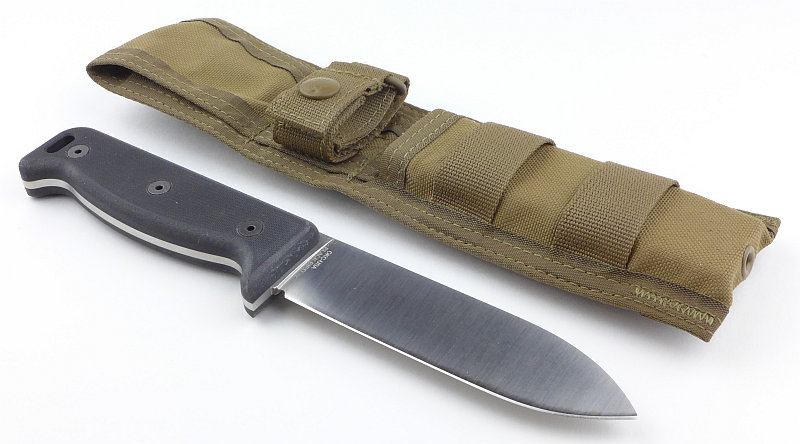The Ontario Knife Company Black Bird SK-5 review is the third of a three-knife review series featuring the Black Bird SK-5, RD Tanto and RTAK II. (See – OKC Group Review.)
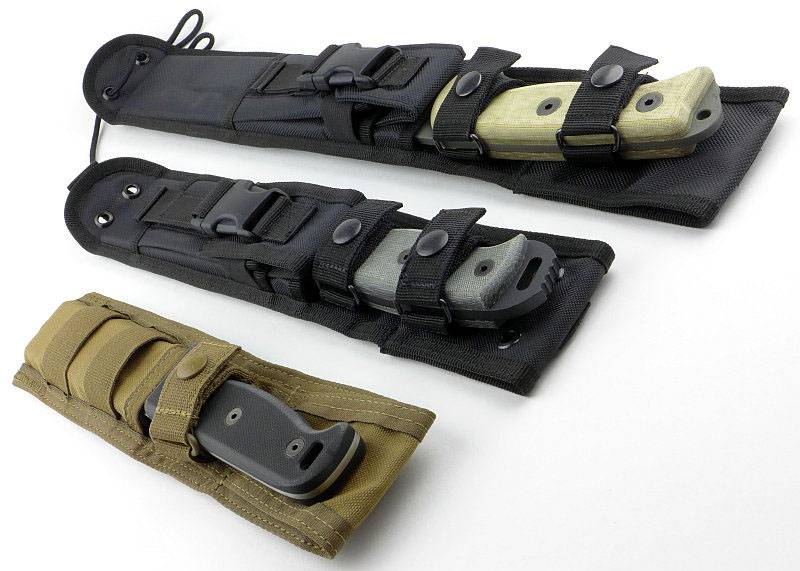
The Black Bird SK-5 is a survival knife designed by Paul Scheiter and is intended to be highly functional and yet very simple.
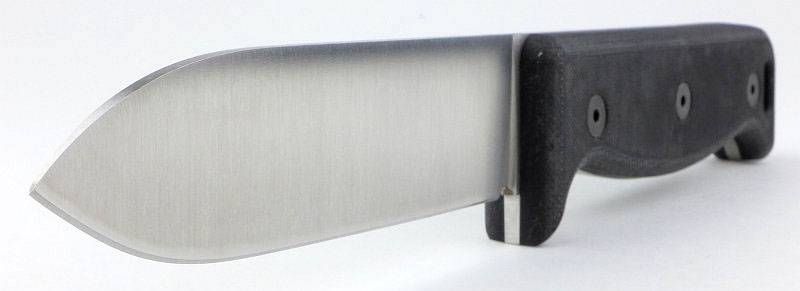
The Blade and Handle Geometry:
Most knives specifications have a basic description of the blade geometry, but in this section I will be taking a more detailed look at geometry and balance.
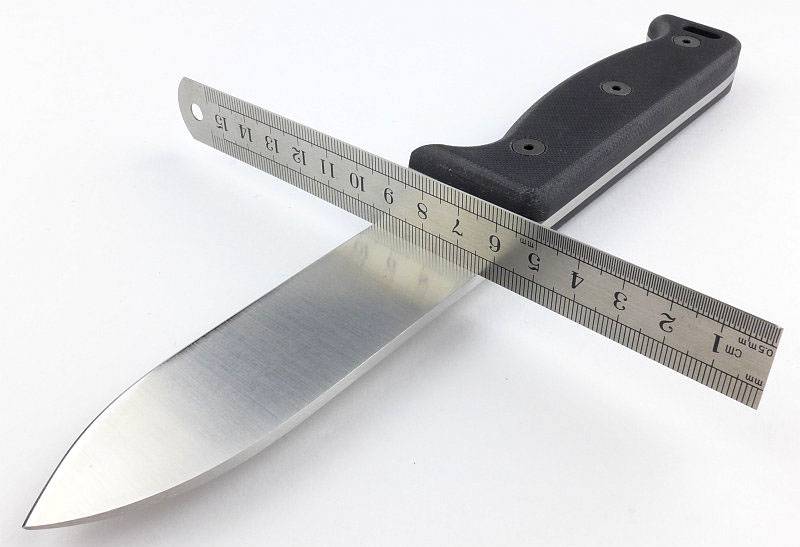
Using a set of gauges and precision measuring equipment including a Vernier protractor, callipers, fixed radius gauges and the unique Arc Master adjustable radius gauge (the one that looks like a crossbow).
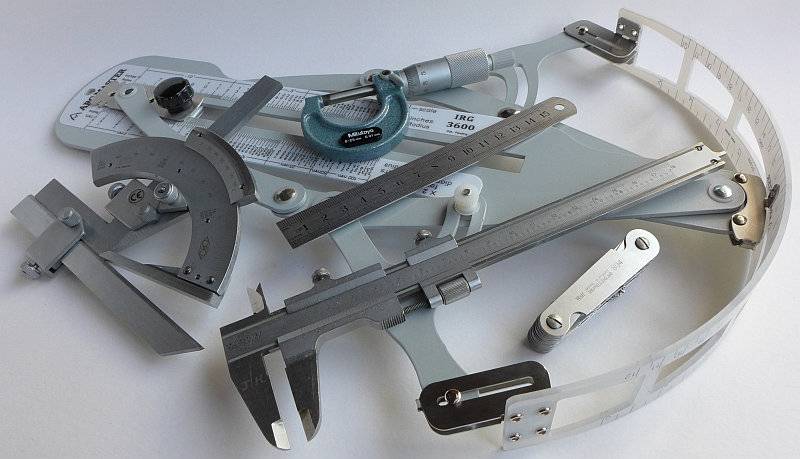
These measurements have been tabulated and are presented along with a few reference blades (8″ Chef’s Knife, 5.5″ Santoku and the popular Fällkniven F1).
Key aspects such as the primary bevel angle, grind type, blade depth, blade thickness, length, weight are detailed, along with balance information.
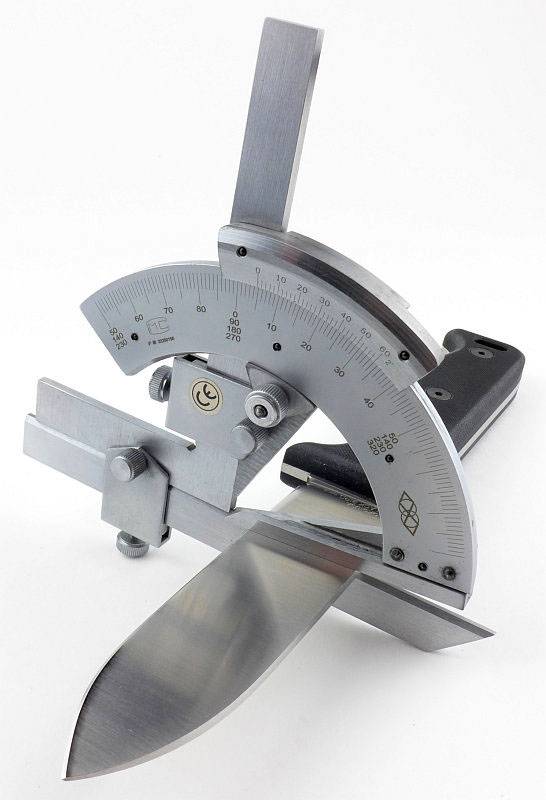
The ‘Balance relative to the front of the handle’ tells you if the knife will feel front heavy, or if the weight is in your hand (a positive value means the weight is forward of the front of the handle). The ‘Balance relative to the centre of the handle’ indicates how close to a ‘neutral balance’ the knife has in the hand.

In the case of full convex grinds the approximate centre of the grind is used for the primary bevel angle estimate.
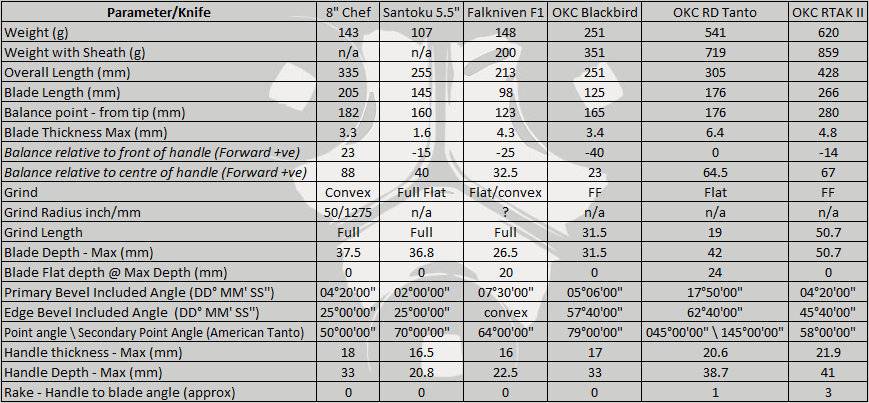
The blade is made from 154CM steel.
Explained by the Maker:
The reasons for certain design choices may not be clear when simply looking at an object, so this section is intended to give an insight into the thinking behind a design by speaking to the designer themselves.
Unfortunately I can’t always get time with the designer so will use this section to include relevant information about the knife and its designer. The following information was noted from an interview with Paul Scheiter by Adam from Equip2Endure
Starting with the name, why is it the SK-5? Well, the ‘SK’ of ‘SK-5’ stands for Survival Knife and the ‘5’ is for its 5 inch blade length, so SK-5 allows for a possible future series with an SK-4 and SK-3.
The concept of this knife is to have sheer simplicity and to achieve maximum function because of that. There is nothing gadgety on the knife, and it only has the bare basics. This gives a knife that has everything it needs and nothing that it doesn’t.
The result is something that is very comfortable in the hand which you can use for hours on end. There are no abrupt angle changes anywhere that your hand would come in contact with, so you are not going to get hotspots and blisters. This is really important for a survival knife where you will be doing a lot of wood processing and splitting.
A notable point is the steel choice of 154CM; in addition to there being a good compromise of edge retention and corrosion resistance, it allows for there not to be a powder-coat on the blade. Amongst other things, not having the powder-coat makes it easy to strike a ferro-rod.
The full flat grind gives the ideal cutting geometry; it stays as thin as possible for as long as possible, and reduces the calories used when cutting wood.
A spear point tip puts a little more metal behind the point, making it less prone to breaking if it gets torqued. The tip itself is placed in the dead centre line of the blade making tasks, such as the initial shaping of a bow drill pit, straightforward as this knife will drill very nicely.
The pommel of the knife is flat and perpendicular to the blade so that if you wanted to use it as a spear head (which would not be recommended, but sometimes it may be a necessity), you can carve a shelf into a piece of wood so the pommel seats perfectly onto this, giving you thrusting power, then you put the lashing around the handle to complete the spear.
Blade stock thickness at 0.13 inches was chosen as a sweet spot where you can confidently baton with it but not take away too much from wood carving which is the primary intention.
At various shows, Paul has noted that people have generally been surprised that it is a lot lighter than it looks.
On a final note about how to carry the knife, Paul Sheiter’s preferred carry option is not to wear the knife on his belt but to use a high over-the-shoulder strap/band (like a cross-body sling bag) as it allows the knife to be kept in sight to the front of the body and if wearing a winter coat you don’t have to lift the coat to access the sheath.
A few more details:
Just as with the others in this series, the Black Bird SK-5 comes in Ontario Knife Company’s standard knife box.
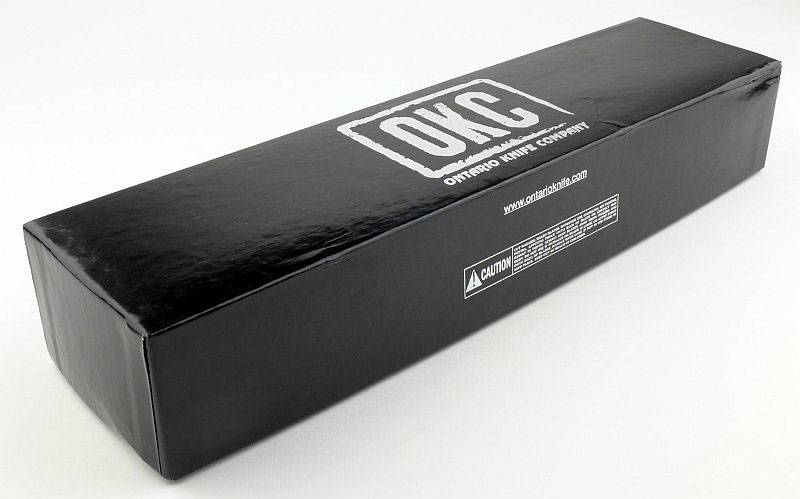
Inside the box the knife has a cardboard protector over the blade, and the knife is not fitted into the sheath. There was also a letter explaining that this knife had upgraded G-10 handle slabs.
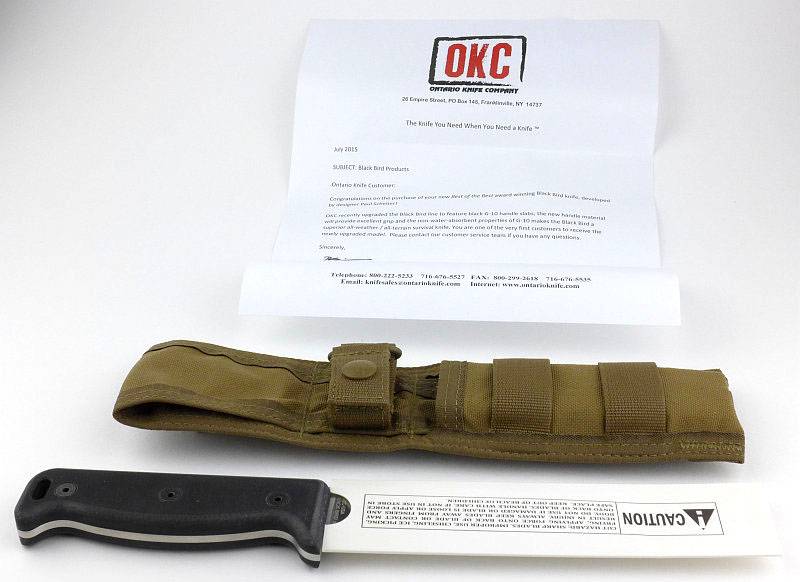
The first proper view of the Black Bird and its sheath.
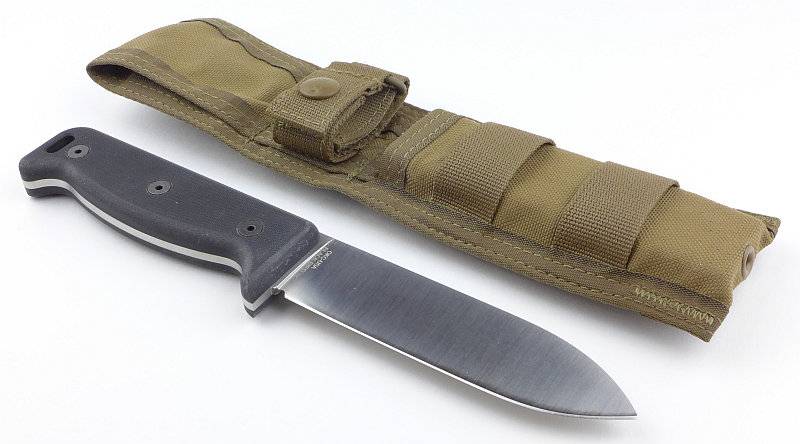
Before going back to the knife, a quick look at a few details of the sheath. On the back, the sheath has a PALS/MOLLE strap for mounting on a pack, vest or load carrier.
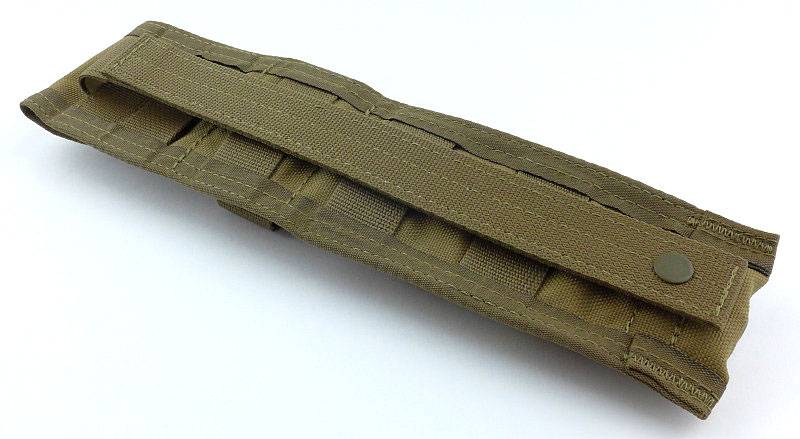
The press stud used on the retention strap is a military specification type where you can only release it from one direction.
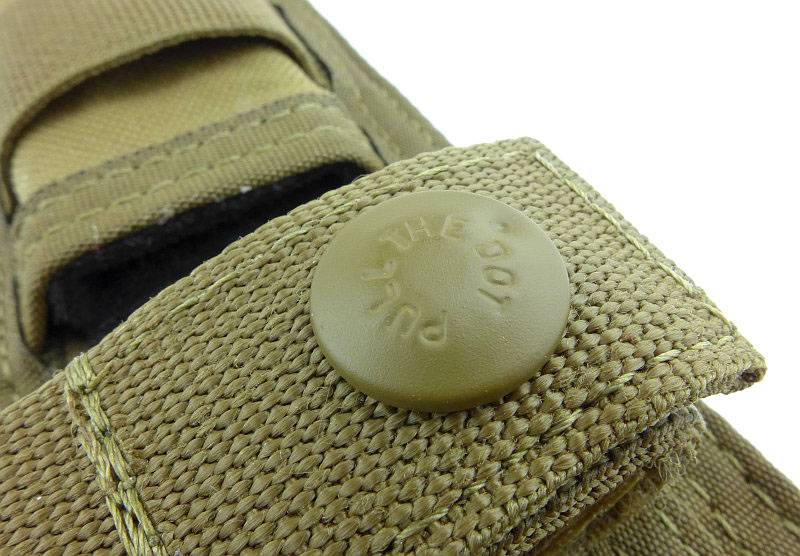
It is possible to change the fit of the retention strap using the Velcro adjustment.
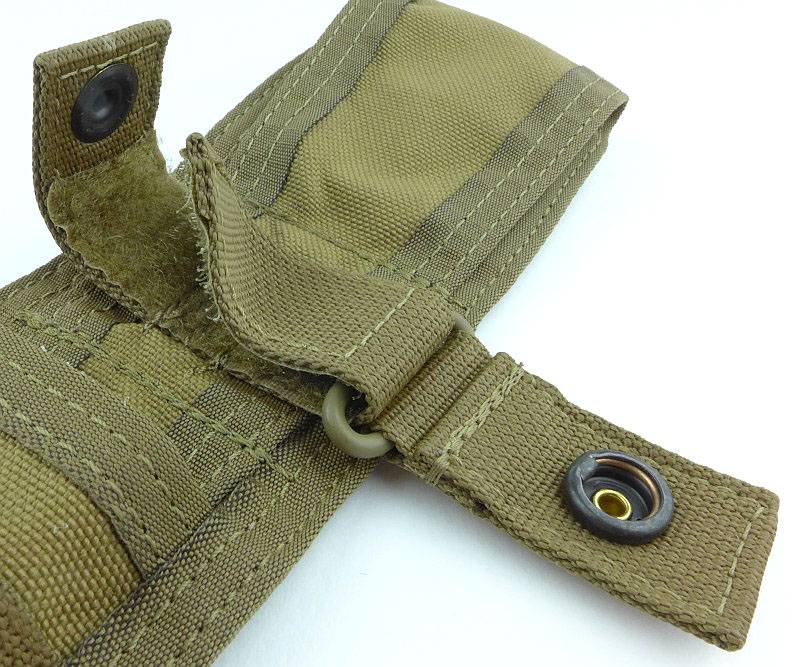
Inside the sheath is a felt liner.
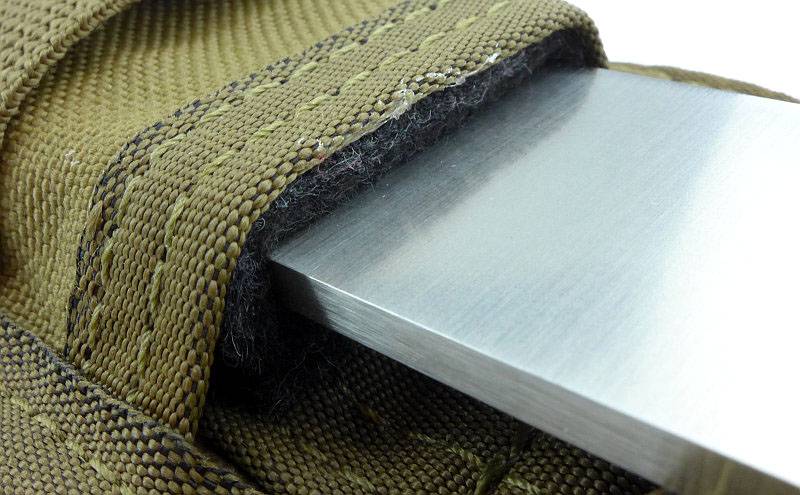
As well as there being PALS webbing on the front of the sheath, here you can also see the drainage hole at the bottom to allow water out.
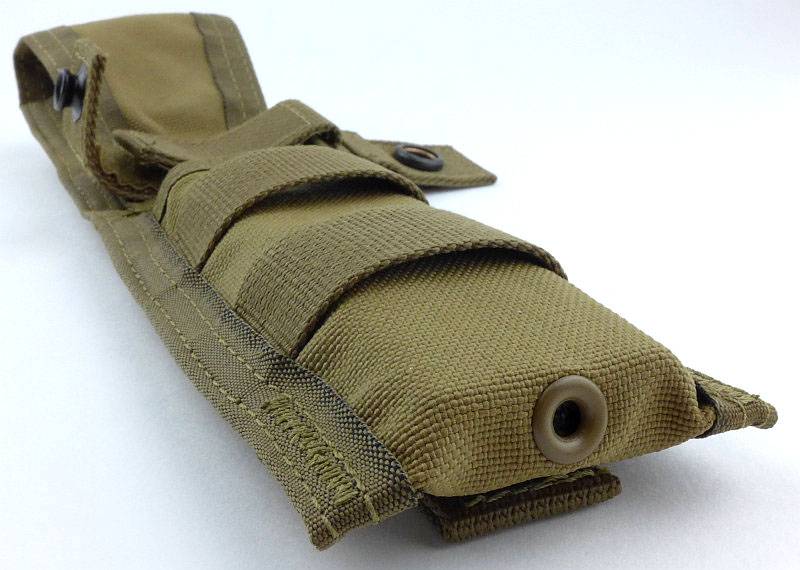
Back to the knife and its details. On one side the maker and model are engraved on the blade near next to the handle.
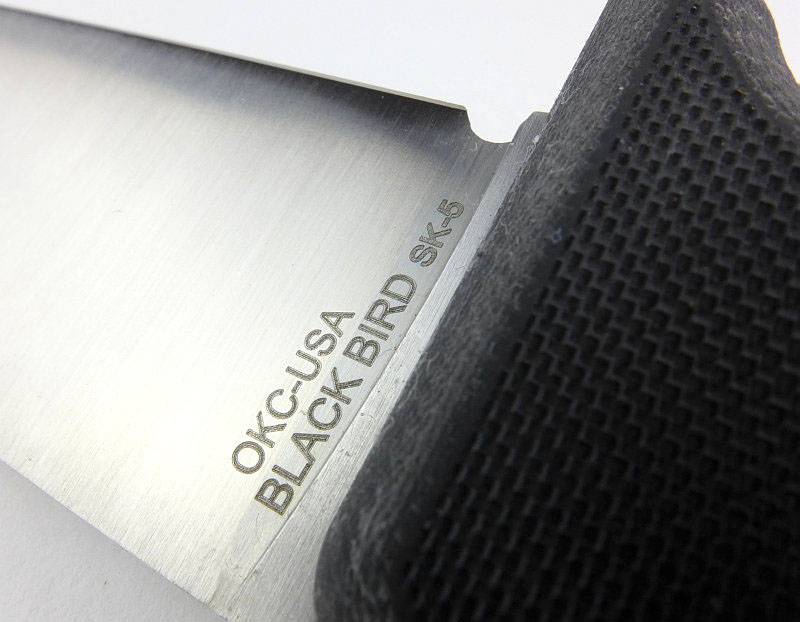
There are three details I’d like focus on in this photograph:
– The generous lanyard hole allows for easy fitting of a lanyard.
– Inside the lanyard you can see evidence of the water-jet cutting and slightly imperfect fit of the handle material, but on the outer edges of the handle and blade tang have been ground to a smooth finish.
– We are looking at the handle grip hook which gives plenty of purchase for all tasks.
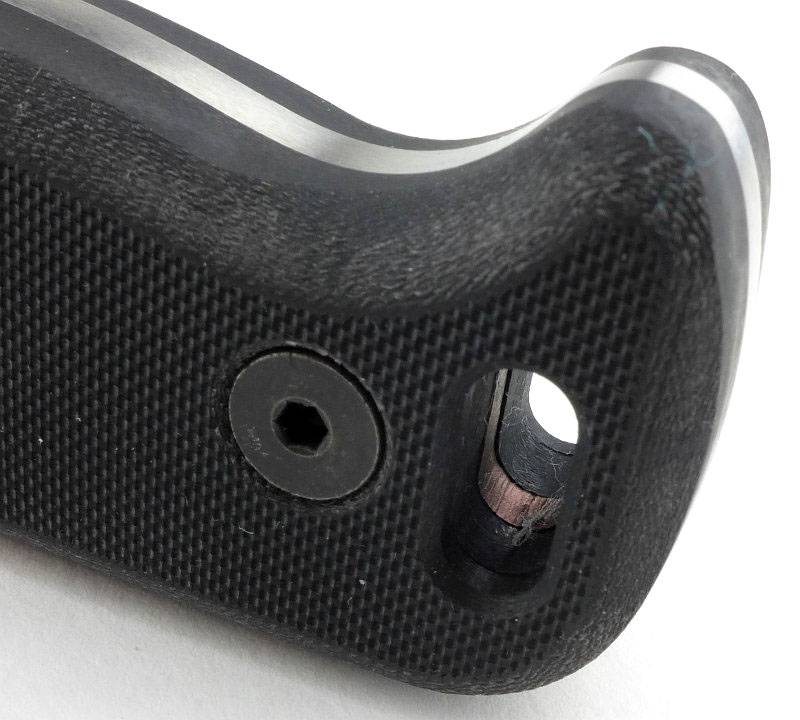
Although the handle slabs are flat sided, they have been well rounded to remove sharp edges. Three bolts are used to secure the grips.
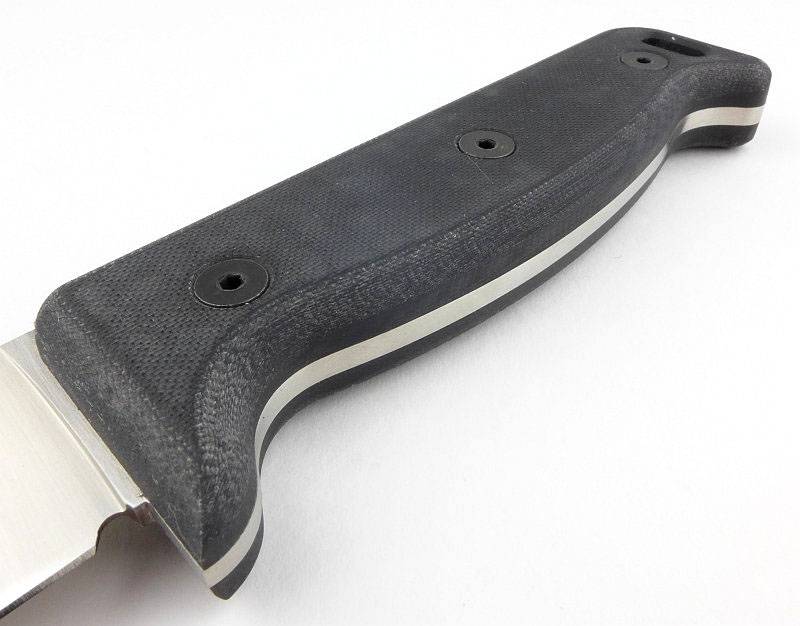
A close look at the blade tip showing the blade-flat surface finish as well as the factory edge and its finish.
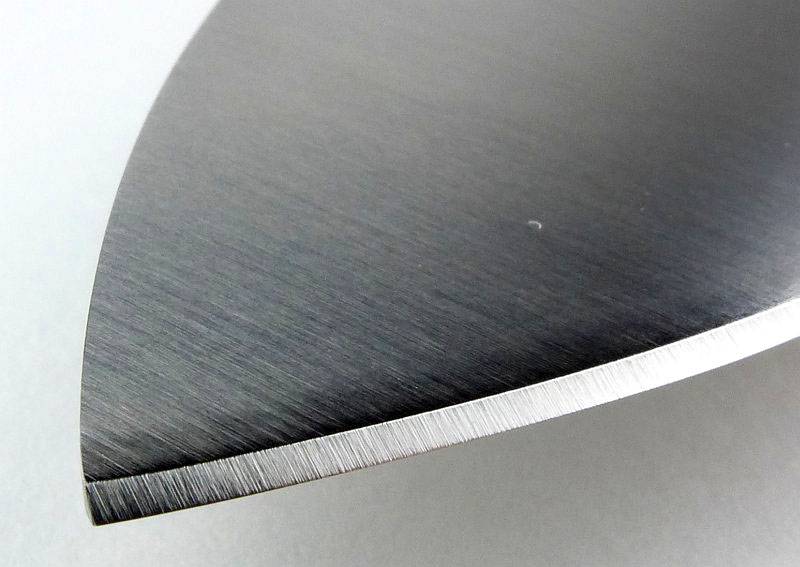
One of my personal preferences, a sharpening choil.
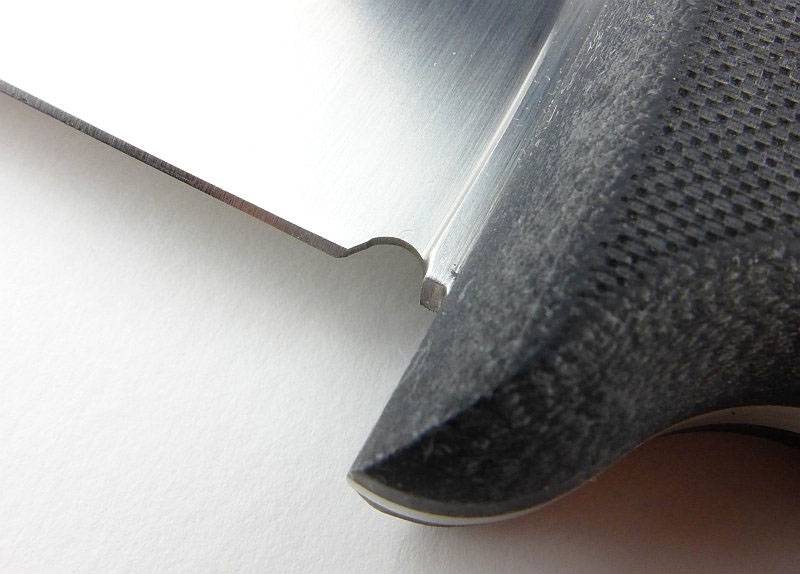
As mentioned earlier, the handle slabs and blade tang are ground/sanded to a completely flush fit.
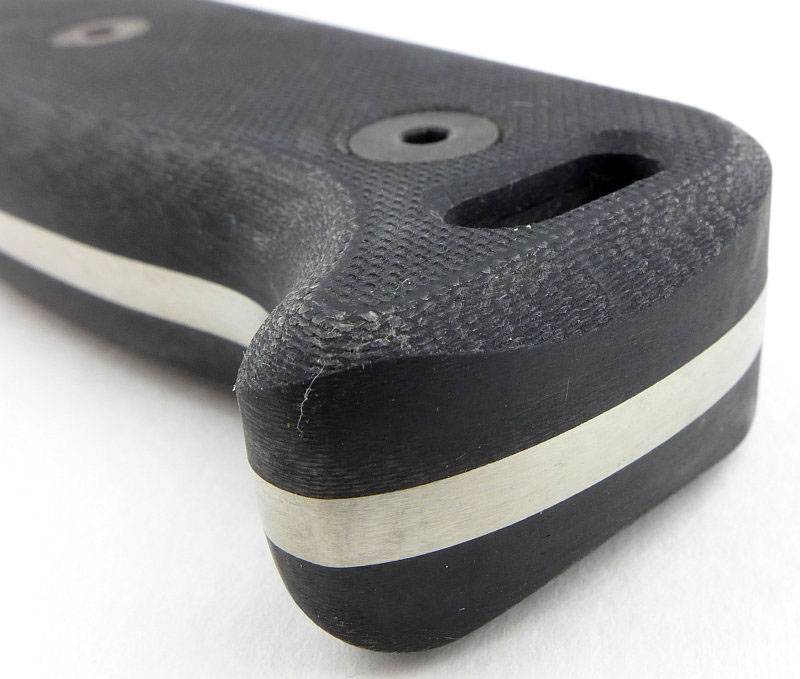
A sharp edge is left all along the spine meaning you can strike a ferro-rod from any part of the spine that suits you.
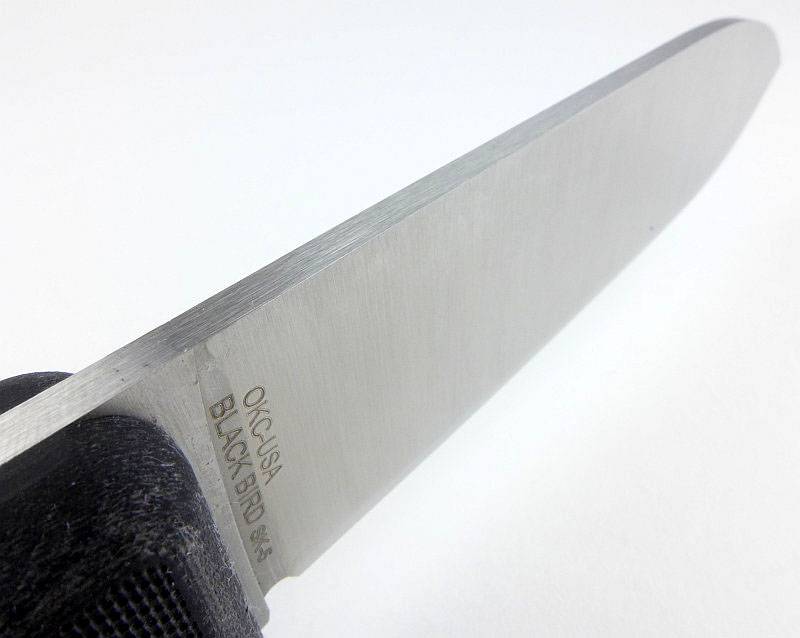
Though not a mirror finish, you can see the reflection of the handle on the blade flat so you could use the knife for signaling.
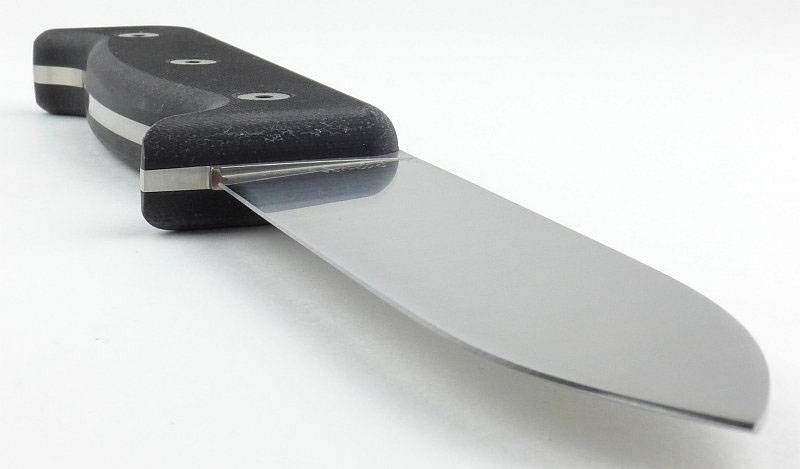
Unlike the other OKC knives in this series of reviews, the Black Bird’s sheath has only a single retaining strap. There is enough room for the knife to come about half an inch out of the sheath with the retaining strap closed.
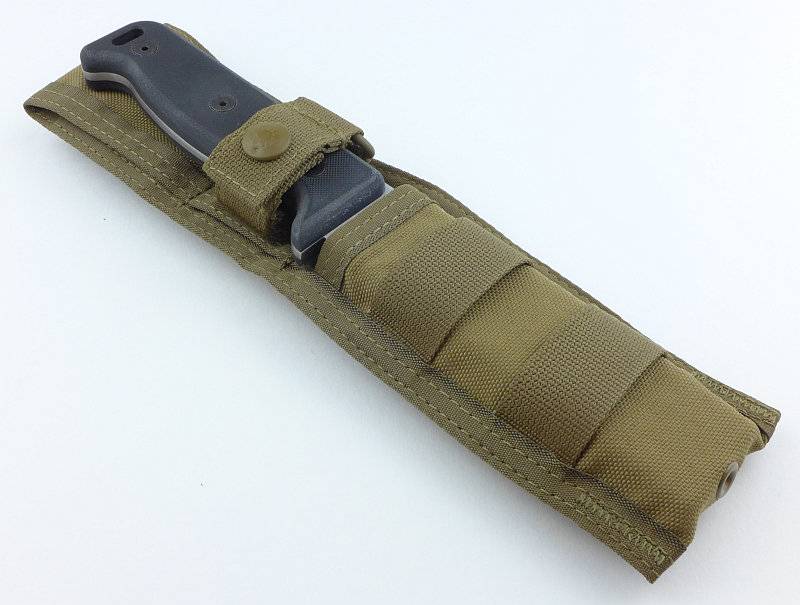
For the last photo in this section, we have en extremely close view of the peely-ply G-10 handle texture.
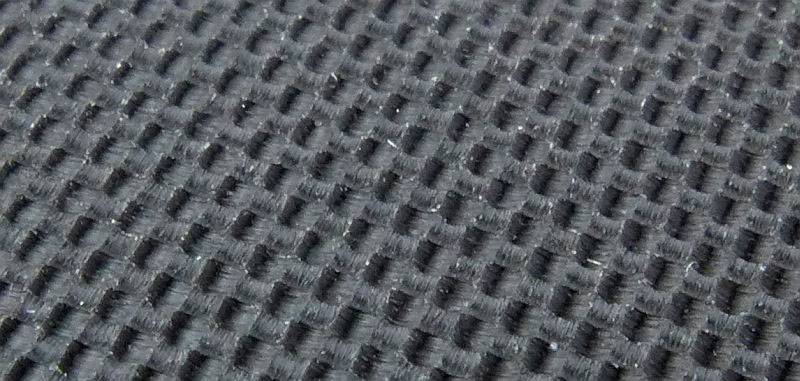
What it is like to use?
As the designer Paul Scheiter noted earlier, the SK-5 does feel lighter in the hand than you would expect – immediately manoeuvrable and easy to use. This is largely thanks to the full flat grind keeping just enough steel in the blade for strength without being overly thick and heavy.
There is no ‘ideal blade length’, as everyone has their own preferences, but being the only Black Bird so far, the choice of 5 inches for a general purpose survival knife is really hitting the spot for me.
To give an idea of scale, here it is next to the Fällkniven F1 and a Spyderco UK Pen Knife.
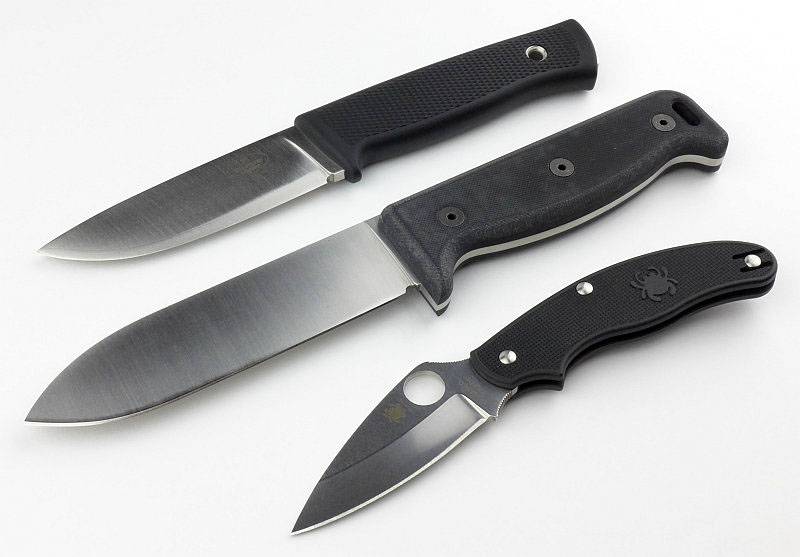
At 5″, the blade is half the overall length of the knife. Combining this with the full flat grind and full tang, even though the blade is 5″, the balance point is brought right back into the hand (see ‘The Blade and Handle Geometry:’ section), and this is the reason it feels light and easy to handle.
With this blade length you still have great control over the point and enough length to make batoning easy (if you need more than 5″ to baton, you should probably choose smaller wood or be making wedges for splitting instead).
Overall the package is small enough to carry easily, immediately making it more likely to be your survival knife (as a ‘survival knife’ is the knife you have with you when you need it).
The Black Bird is extremely comfortable in the hand, though the grip is a little boxy due to the flat sides.
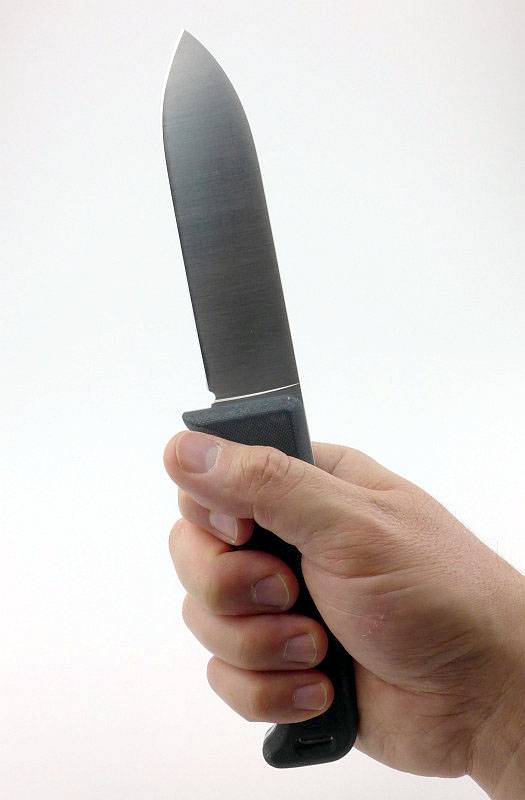
Not to get started on the subject of factory edges (which by necessity have to be created quickly, typically with belt sanders, and are usually not the best edge that knife can have), but in this case I need to mention the factory edge on the Black Bird sample I received. Check back to the measurements I took and you see it was a 58 degree inclusive angle out of the box; this is more like an angle you might choose for an axe. My initial testing was with the factory edge including comparing it to the other OKC knives. (OKC said this was an anomaly as the factory edge is not normally that steep)
Despite such a large edge angle it still cut very well just requiring a higher angle of attack for each cut. Unsurprisingly it was by far the most controlled carver of all three.
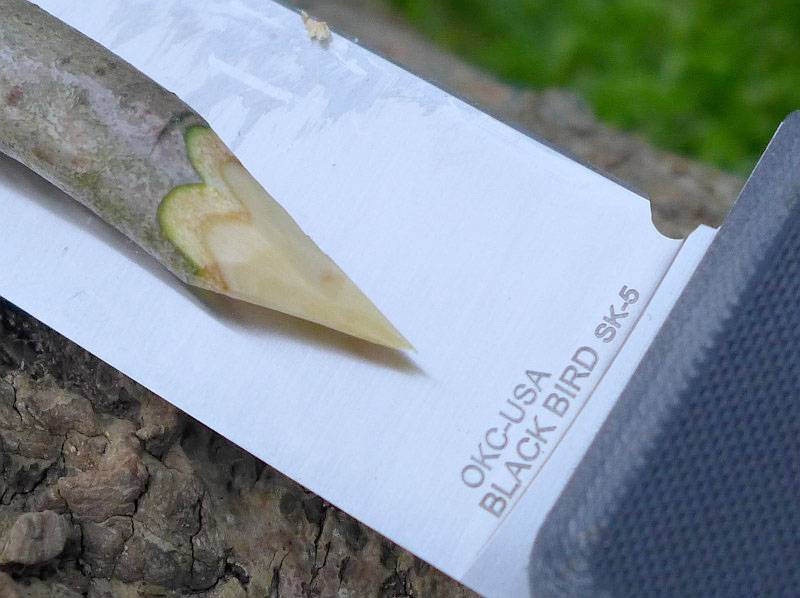
Despite not needing a sharpen at this point, I wasn’t satisfied with the factory edge angle, so decided to reprofile to around 38 degrees. Even using DMT diamond stones, the 154CM steel proved to be very hard to work and the reprofiling took me a good four hours. The edge bevel is around three times as wide as the original factory edge. Was it worth it? Well, YES, a complete transformation!
Reprofiling the edge has taken a capable cutter and made it supremely efficient and eager. On a simple paper cut test it now glides through with a push cut where previously it cut perfectly well but needed some drawing across the edge. In wood I have to be careful not to over-cut. (Remember to sharpen your knives to suit you and don’t be afraid to change the edge angle)
Another characteristic this knife has is its inoffensive look. By this I mean the fact that it has a SAK style spear point which makes it look more utilitarian than many ‘survival’ knives on the market. If other people are more comfortable when they see the knife you are more likely to carry it and have it with you when you need it (if you are bothered what others might think). Obviously when sheathed you can’t see this, but overall it is easy to carry unobtrusively. If you take it out to whittle or use it for frivolous cutting tasks it doesn’t look like a weapon. It might seem a minor point, but so far I’ve found this knife getting more positive reactions than any other I’ve carried.
Review Summary
The views expressed in this summary table are from the point of view of the reviewer’s personal use. I am not a member of the armed forces and cannot comment on its use beyond a cutting tool or field/hunting knife.
Something that might be a ‘pro’ for one user can be a ‘con’ for another, so the comments are categorised based on my requirements. You should consider all points and if they could be beneficial to you.
| _______________________________________________ | _______________________________________________ |
| Things I like | What doesn’t work so well for me |
| _______________________________________________ | _______________________________________________ |
| Excellent Handling and Balance. | Grip could be more contoured. |
| Comfortable for extended use. | Factory Edge too steep. |
| 154CM steel with great edge retention. | 154CM is harder to sharpen than other steels. |
| Full Flat Grind. | |
| Showers sparks from ferro-rods. | |
| Aftermarket sheaths available. |
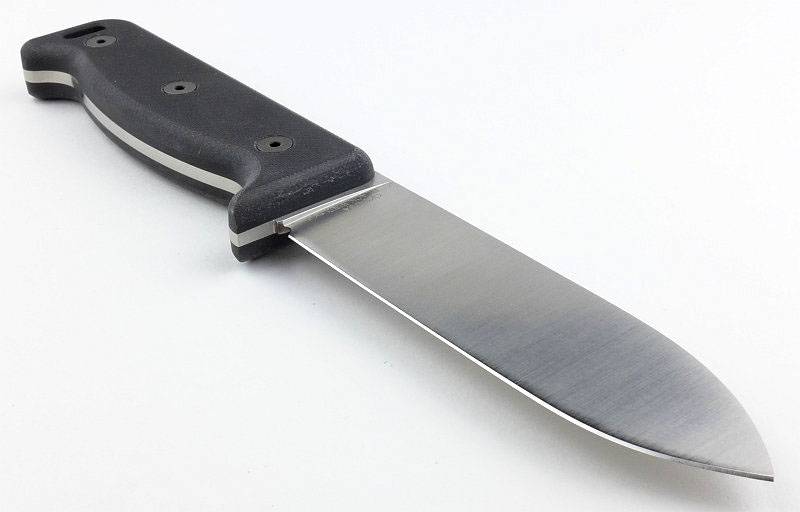
Discussing the Review:
Please feel free to add comments to the review, but the ideal place to freely discuss these reviews is on a forum. If you started reading the shorter forum version of the review, but followed the link this full exclusive review, please return to that forum to discuss the review there.
If you read the review entirely on Tactical Reviews, please consider one of the following to join in any discussion.
EdgeMatters – Sponsored Reviews (UK based Forum for Knife Makers and Collectors)
BladeForums – Knife Reviews (US based Forum for Knife Discussion)
CandlePowerForums – Knife Reviews Section (Largest and Friendliest Flashlight Community Forum)

